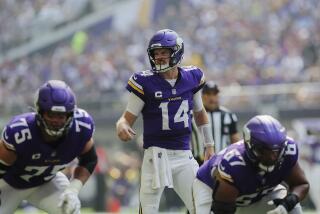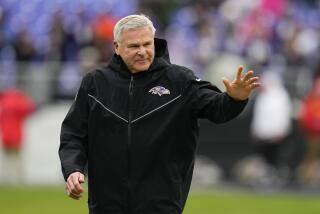Bill Walsh was coach, general manager, football man for ages
- Share via
Bill Walsh was celebrated as the best NFL coach of the last quarter-century, one whose offensive innovations are being used today in some form by almost every team.
But he was more than that. Almost alone among coaches, past and present, he was among the best ever at the two keys to success: acquiring players and coaching them.
“He not only was one of the five best coaches ever, but he was one of the five best personnel men ever,” says Bill Polian, who built Indianapolis’ Super Bowl winner and also put together the Buffalo team that went to four straight Super Bowls nearly two decades ago.
Walsh died Monday following a long battle with leukemia. He was 75.
List the great coaches and they start with George Halas, who in 1920 basically founded what is now the NFL. He was owner, general manager and coach of the Chicago Bears and, essentially, commissioner -- nothing important happened in the NFL without his approval.
But the modern NFL began after World War II and its most important figure was Paul Brown, whose Cleveland Browns in the All American Football Conference were the prototype for all great franchises. Walsh, no surprise, was mentored by Brown a decade later in Cincinnati and so were Chuck Noll and Don Shula.
Historically?
Halas was a great coach, but he was as much an owner and a pioneer.
If you start after World War II, six coaches stand above the rest: Brown, Vince Lombardi, Tom Landry, Shula, Noll and Walsh. And while Landry was the face of America’s Team for 28 years, Noll won four Super Bowls with the Steelers, and Shula won more games than anyone in history, it’s not a stretch to rank Walsh, who coached for only 10 years, in the top three.
“I always said that he was an artist and all the rest of us were blacksmiths pounding the anvil, while he was painting the picture,” Seattle coach Mike Holmgren said.
Holmgren represents the enduring effect that Walsh had -- he learned the West Coast offense from the master and then spread it to the likes of his own assistants, including Jon Gruden, Andy Reid and Steve Mariucci.
But that all began with Brown, who spawned so many coaches and taught so many others -- he was the first coach to actively seek out black players, signing Marion Motley and Bill Willis in 1946, a year before Jackie Robinson broke the color barrier in major league baseball. Nearly 40 years later, Walsh was one of the first head coaches in the NFL to hire multiple black assistants and encourage the best of them -- Dennis Green, Ray Rhodes -- to pursue careers as head coaches.
During his years as the 49ers’ head coach -- 1979-88 -- his team won three Super Bowls and the ’89 team, which won under George Seifert, was basically his.
He might have won two or three more had the NFC not been so laden with superpowers during that era: the 1985 Bears, plus the multiple Super Bowl-winning Redskins and Giants.
How did Walsh compare to his most successful contemporaries and competitors during the 1980s -- Joe Gibbs in Washington and Bill Parcells in New York?
Gibbs and Parcells coached players provided them by Bobby Beathard and George Young, who had helped Shula build powers in Miami. Walsh coached players he found himself, the inspiration for Parcells’ line when he was seeking more power in New England: “If I cook the meal, I want to shop for the groceries.”
But Parcells was never the grocery shopper Walsh was. His specialty was assembling role players to surround superstars Joe Montana, Jerry Rice, Ronnie Lott and Steve Young. He got eight starters for the 1988 and 1989 champions in rounds two through six of the 1986 draft.
The talented Young became available when Tampa Bay used the first pick of the 1987 draft on Vinny Testaverde. Young himself convinced the Bucs not to trade him to the hapless Cardinals and Walsh jumped in and made the deal.
He got a player who could push what he sensed was a complacent Montana to greater heights and one who eventually replaced him and won a Super Bowl of his own.
Another innovation: the scripting of plays to start a game, something even the most conservative coaches (Tom Coughlin, for example) do today.
“He was one of those unusual people who could say, ‘Here’s a play, it’s going to work, and here’s what’s going to happen.’ ” Gibbs said. “That’s one of the hardest things in football.”
There also were things the public rarely noticed about his teams.
The offenses, for example, were always so good that the defenses were overlooked.
Yet his first 49er Super Bowl winner had three rookies starting in the secondary, one of them Lott, who became a Hall of Famer. That wasn’t Walsh’s best team but it may have been his best coaching job. Montana was still young, there was no running game to speak of and Rice was four years away from being drafted.
But the defense held up because he bought the right groceries, adding veterans Jack “Hacksaw” Reynolds and Fred Dean to those young DBs.
“I loved discussing football with him,” Polian said. “He used to say ‘You coach offense, but you draft defense.’ ”
More to Read
Go beyond the scoreboard
Get the latest on L.A.'s teams in the daily Sports Report newsletter.
You may occasionally receive promotional content from the Los Angeles Times.










